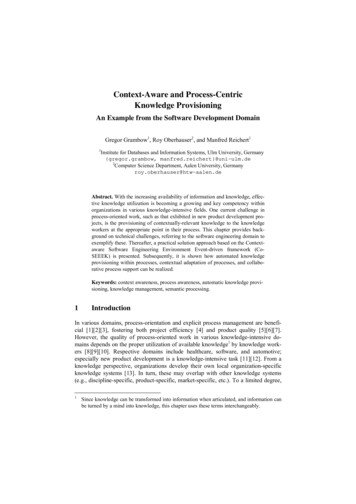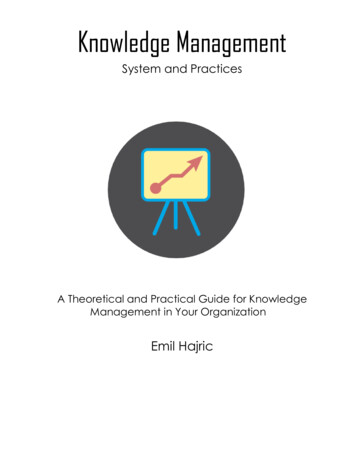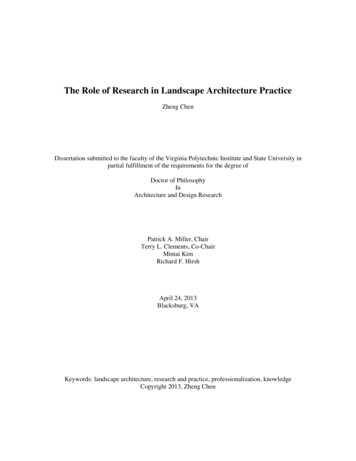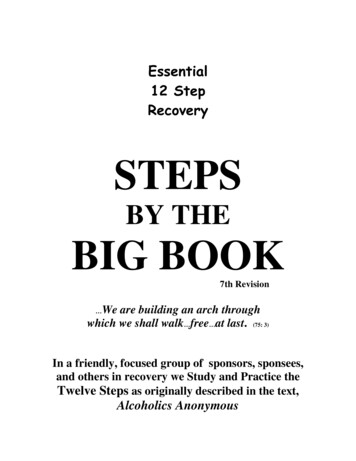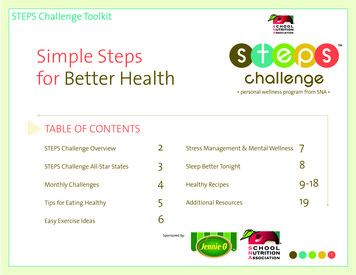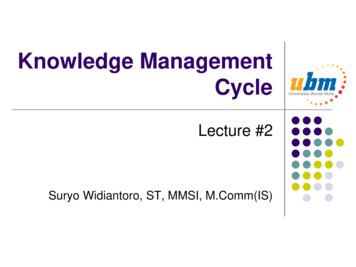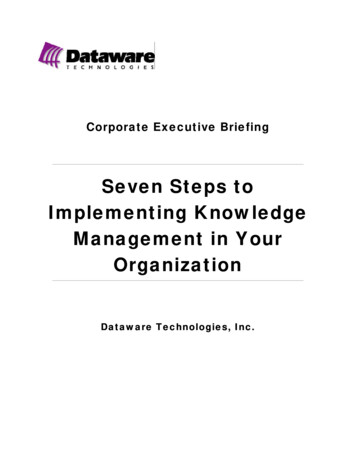
Transcription
Corporate Executive BriefingSeven Steps toImplementing KnowledgeManagement in YourOrganizationDataware Technologies, Inc.
CopyrightThe entire contents of this document are copyright 1998 by Dataware Technologies, Inc. No part of this documentmay be reproduced or transmitted in any form, by any means without the expressed, written permission of DatawareTechnologies, Inc.TrademarksDataware is a registered trademarks of Dataware Technologies, Inc. All other product names are trademarks orregistered trademarks of their respective owners.Dataware Technologies
Table of ContentsEXECUTIVE SUMMARY. 1INTRODUCTION . 3STEP 1: IDENTIFYING THE BUSINESS PROBLEM. 3BUSINESS OBJECTIVES SHAPE KNOWLEDGE MANAGEMENT. 4STEP 2: PREPARING FOR CHANGE . 4CHANGING TO A KNOWLEDGE SHARING CULTURE . 5EXECUTIVE SUPPORT IS KEY . 5STEP 3: CREATING THE TEAM . 5STEP 4: PERFORMING THE KNOWLEDGE AUDIT. 6IDENTIFY WHAT’S MISSING . 6ORGANIZING KNOWLEDGE . 7STEP 5: DEFINING KEY FEATURES. 8OPEN AND DISTRIBUTED . 8MEASURABLE . 8CUSTOMIZABLE . 9SECURE . 9STEP 6: BUILDING BLOCKS FOR KNOWLEDGE MANAGEMENT . 10META-LEVEL SEARCH BROKER - QUERYING ACROSS EXISTING REPOSITORIES . 13KNOWLEDGE MINING. 13AUTOMATED CATEGORIZATION . 13THE KNOWLEDGE WAREHOUSE . 14CAPTURING TACIT KNOWLEDGE . 14KNOWLEDGE MAPPING . 14STEP 7: LINKING KNOWLEDGE TO PEOPLE. 14A KNOWLEDGE DIRECTORY . 14CONTENT MANAGEMENT . 15CONCLUSION . 15Dataware Technologies
APPENDIX A - CASE STUDY . A-1CASE STUDY: PROBLEMS AT ACE . A-1CHANGES AT ACE: HUMAN AND TECHNICAL . A-1THE ACE KNOWLEDGE MANAGEMENT TEAM . A-2ACE PERFORMS A KNOWLEDGE AUDIT . A-2ACE REVIEWS, SHOPS, AND PLANS . A-4ACE IMPLEMENTS ITS BUILDING BLOCKS. A-4ACE ENHANCES ITS KNOWLEDGE MANAGEMENT SYSTEM. A-6ACE EXPANDS PARTICIPATION IN KNOWLEDGE MANAGEMENT . A-10KNOWLEDGE MANAGEMENT BENEFITS APPEAR AT ACE . A-11APPLICATIONS OF KNOWLEDGE MANAGEMENT EXPAND AT ACE . A-11APPENDIX B - ABOUT DATAWARE TECHNOLOGIES, INC. . B-1Dataware Technologies
Executive SummaryAs the information age has transformed the way organizations do business, it has also transformed the way wemeasure return on investment (ROI). Today, to have a truly competitive, fast-paced business positioned for profit,success and long-term survival, it is critical to look past the physical assets of the organization. Today, it is essential torecognize the value of “knowledge” and to strive for an improved ROI and better management of your organization’sknowledge assets.Perhaps your organization has already recognized the value of the knowledge that it has spent its hard-earned capitalto obtain. If so, you may already be taking steps to formalize the collection of valuable knowledge gained fromexperience and organizing knowledge in ways that benefit the entire organization. If you have not started to take thesesteps, your organization is most likely wasting resources by re-inventing knowledge, spending excess time locatingdifficult to find knowledge and unsuccessfully absorbing and using the growing volumes of new knowledge flowinginto your organization every day.Recent advances in information processing technology, combined with widely available access to high-speed networks,provide organizations with unparalleled opportunities to formalize the collection, protection and use of knowledge. Toaccomplish this, new software systems and processes have been developed to integrate with existing informationsystems and spread throughout the enterprise. These new approaches are collectively referred to as “KnowledgeManagement”.This executive white paper presents a blueprint to start or refine the implementation of Knowledge Managementpractices and systems in your organization. This paper presents a gradual, “building-block” approach to implementingKnowledge Management that follows three principles: build on existing resources and systemsprovide an immediate ROI on knowledge resourcesensure that each step is a building block that provides a foundation for future enhancementsFrom these three principles, this paper presents a series of seven steps to implement Knowledge Management, asfollows:Step 1: Identify the Business ProblemStep 2: Prepare for ChangeStep 3: Create the KM TeamStep 4: Perform the Knowledge Audit and AnalysisStep 5: Define the Key Features of the SolutionStep 6: Implement the Building Blocks for Knowledge ManagementStep 7: Link Knowledge to PeopleIt also presents specific technical solutions and capabilities that allow for a step-by-step implementation of theKnowledge Management Building Blocks mentioned in Step 6. These solutions are: Access existing Knowledge Silos to get immediate ROI from your existing resourcesImplement simple Knowledge Mining for more efficient accessAutomatically Categorize to deal with new knowledgeBuild a Knowledge Warehouse to make knowledge widely availableEnable end-user contribution to allow increased knowledge flowExpand the use of metadata and taxonomies for effective categorization of knowledgeLocate the Experts in the Organization - create a knowledge directoryDataware Technologies1
Results have been very positive in organizations that have started to implement Knowledge Management using thisbuilding-block approach. Research information and best practices are shared, experts are identified and cost savingsare realized as employees spend less time locating or reinventing knowledge and more time being productive. Overall,these organizations are more competitive and more effective as they integrate Knowledge Management practices intothe fabric of their organization - they realize higher value from the assets and capital they have used to obtainknowledge.As you read this paper, remember that it presents guidelines to effective implementation of Knowledge Managementin your organization. Like many other processes, there is no “one way” to implement Knowledge Management -especially since KM is a combination of technology, culture and practices. This paper provides an overview of someeffective, proven ways to plan, implement and evaluate the results of Knowledge Management to help yourorganization be more effective and successful.Dataware Technologies2
IntroductionPioneering businesses have been creating knowledge management systems to harness intellectual capital and createvalue. Peter Robertson, for example, is the executive vice president of the Chevron USA Production Co., who recentlydescribed the benefits of knowledge management:“The fact is [knowledge management and best practice sharing] is good for business. The faster and more effectivelywe can share ideas, the better we can make our product, the better we can serve our customers, the better we can builda committed team of employees, and—bottom line—the better we can earn profits for our shareholders.”1How does one harness intellectual capital for profit? This paper describes steps an organization should expect totake—and avoid—when implementing a successful knowledge management system. In addition, it reinforces thisapproach by providing a case-study detailing the implementation of knowledge management at a large company –(designated as “Ace Chemical” for the purposes of this paper). The knowledge management challenges at Ace aretypical; they concern people, content, and economics more than they concern technology. However, it is thetechnology—the knowledge management system—that ultimately enables the organization’s knowledge managementpractices.At the outset, the challenges of knowledge management may sound daunting and perhaps esoteric. Tom Davenport,director of the Information Management Program at the University of Texas at Austin, believes that knowledgemanagement is a costly, political, and ceaseless process—but a process that corporations cannot afford to avoid. Heasks a practical question regarding knowledge management: “How much does it cost an organization to forget whatkey employees know, to be unable to answer customer questions quickly or at all, or to make poor decisions based onfaulty knowledge?”2.It is this practical approach to implementing knowledge management to bring real benefits to your organization thatforms the core ideas presented in this paper.Step 1: Identifying the Business ProblemKEY CONCEPT: Successful implementation of knowledge management requires a clear identification of thebusiness problem to be solved and an alignment of the knowledge management project with overall businessobjectives.Employees charged with implementing a knowledge management system almost always face an initial fear—fear of ahopelessly large amount of up-front work. Consider the quantity and diversity of information recorded in corporatedatabases, available on the Internet, and stored in peoples’ heads at global corporations. Transforming thatinformation into something valuable—something that employees can access anytime from anywhere and apply to theirjobs—seems daunting.This fear is typically grounded in an attitude that knowledge management is an all or nothing proposition. However,knowledge management is a set of business practices and technology implementation that are applied over time to helpcompanies better manage their intellectual capital —knowledge management is not an end in itself. The buildingblocks for enterprise knowledge management are already familiar to most organizations in the form of basic“information access” applications. These applications take a well defined set of information, such as material safetydata sheets or technical documentation, and create an organized repository that enables users to access and search thespecific content. Implementation is usually direct, quick, inexpensive, and a good first step toward enterpriseknowledge management.1Susan Elliott, “American Productivity & Quality Center Conference Attendees Discover the Value and Enablers of a Successful KM Program,”Knowledge Management in Practice, Issue 5, December 1996/January 1997, p. 12Britton Manasco, “The Trials and Triumphs of the Knowledge Era,” Knowledge, Inc., http://webcom.com/quantera/empires.htmlDataware Technologies3
Corporations that want to tackle more diverse and dynamic knowledge need not fear up-front costs, either.Organizations need only to attack a single business problem to begin to infuse knowledge management methodologiesinto their daily activities and add value to the organization. At Echo, Inc., for example, a maker of outdoor powerequipment in Lake Zurich, Ill., the problem that inspired knowledge management was a staffing shortage. Tradeschools were eliminating specialized engineering training that Echo needed, so Echo decided to capture problemsolving techniques in a central location for widespread use.3Business Objectives Shape Knowledge ManagementIt is essential that companies align knowledge management projects with business objectives. Dave Ledet, director ofshared learning at Amoco Corp., found that if business objectives are not stated or are not clear for the knowledgemanagement effort, it “tends to become just another activity imposed on people for no apparent reason.” He lists thefollowing areas of focus: financial objectives, quality, customer satisfaction, and innovation.4Another reason for focusing knowledge management efforts on a set of clear objectives is that most successfulknowledge management projects start small and are tested thoroughly. The ideal is to test the process and culturalchanges—not merely the software—on a small scale and then refine and apply the techniques to other businessproblems across the organization.Finally, clearly focused knowledge management projects avoid information overload. In the 1990s, Arthur Andersenstarted its Global Best Practices (GBP) knowledge base. Early in the lifecycle of GBP, GBP team responses toexperienced user demand for more information lead to content volume increasing thirty-fold. The result was “anunwieldy blob of information”5 that turned casual users into non-users. The team realized it had sacrificed speed andspecificity for size and generality. Eventually, Arthur Andersen chose alternate delivery systems for knowledge detailsto keep the GBP application focused and more usable.Step 2: Preparing for ChangeKEY CONCEPT: Knowledge management is more than just an application of technology. It involves culturalchanges in the way employees perceive the knowledge they develop. A successful implementation of knowledgemanagement also requires endorsement from corporate management.Only a fraction of the corporate changes required for successful knowledge management are technical. A commonproblem for those undertaking a knowledge management project is placing technology ahead of the ability or thedesire of people to use it. Tom Davenport believes that two-thirds of a knowledge management effort needs to focus onnon-technical issues:“If you’re spending more than one-third of your time on technologies for knowledge management, you’re neglectingthe content, organizational culture and motivational approaches that will make a knowledge management systemactually useful.”6The good news is that most workers, if given the required time, training and incentives, will begin to capture, manageand share knowledge with enthusiasm. Carla O’Dell and C. Jackson Grayson of the American Productivity andQuality Center (APQC) credit basic human nature:“We believe that most people have a natural desire to learn, to share what they know, and to make things better. Thisnatural desire is thwarted by a variety of logistical, structural, and cultural hurdles . we erect in our organizations.”73Esther Shein, “Keeping the Motor Humming with Data,” PC Week, February 9, 1998, p. 75.Susan Elliott, “American Productivity & Quality Center Conference Attendees Discover the Value and Enablers of a Successful KM Program,”Knowledge Management in Practice, Issue 5, December 1996/January 19975Wendi Bukowitz, “In the Know,” CIO Magazine, April 1, 1996.6Tom Davenport, “Known Evils, Common Pitfalls of Knowledge Management,” CIO Magazine, June 15, 19977Carla O’Dell and C. Jackson Grayson, American Productivity and Quality Center (APQC) “If We Only Knew What We Know: Identification andTransfer of Internal Best Practices” p. 64Dataware Technologies4
Changing to a Knowledge Sharing CultureOne common cultural hurdle to increasing the sharing of knowledge is that companies primarily reward individualperformance. Anne Stuart in CIO magazine writes: “Effective knowledge management requires creating a supportive,collaborative culture and eliminating traditional rivalries. For some employees, that may mean painfully ‘unlearning’long-standing lessons. Someone who interprets the old axiom ‘Knowledge is power’ to mean ‘To stay strong, I’ve gotto hide and protect what I know’ isn’t likely to embrace the concept of sharing resources.”8Creating a collaborative culture may require redesigning organizational values and implementing incentives toencourage participation in meeting organizational goals. Leaders need to preach the gospel of sharing information.Managers need to rate performance based on employees’ cooperative efforts. Rewards, whether they’re key chains,peer esteem, or promotions, need to recognize knowledge sharing.Cultural changes of this magnitude take time. Organizations have to expect that contributions to a knowledgemanagement project and maintenance of a knowledge management system, are an investment in corporate learningand ultimately in corporate efficiency.Dave Ledet, director of shared learning at Amoco Corporation,
knowledge management projects start small and are tested thoroughly. The ideal is to test the process and cultural changes—not merely the software—on a small scale and then refine and apply the techn


